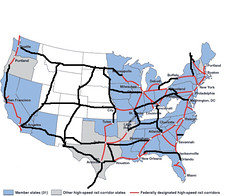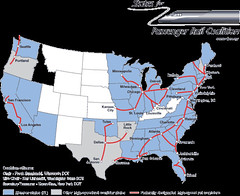"not very good" Associated Press on the opportunities presented by high speed rail
From "Billions for high-speed rail; anyone aboard?":
Since the 1980s, every state effort to reproduce such service has failed. The reasons often boil down to poor planning and simple mathematics.
Most any state effort to deliver high speed rail, except perhaps in a state like California or New York, is likely to fail because to make such systems succeed in all likelihood they need to function on international, national, and/or regional scales.
I define regional as multistate.
See the delineation of transit networks from this blog entry "Second iteration, idealized national network for high speed railpassenger service"
-------
this is based on thinking about transportation networks in five overarching dimensions:
1. International -- connections between countries. (The map above shows a couple connections between the U.S. and Canada, and one connection from San Antonio to Monterrey, Mexico through Laredo.)
2. National -- anchors of a national transportation system, current anchors are the Interstate Highway system, the freight railroad system, and airplane travel. We do not have a national passenger railroad network presently.
3. Regional -- multi-state connections -- for the most part these don't exist for transit, but do for freight railroad, airplane travel, and the Interstate highway system. The Northeast Corridor railroad passenger service offered by Amtrak is an example of such a transit network.
4. Metropolitan -- transit systems like the WMATA subway and bus system, the combined railroad, subway, bus, and waterborne transit services in the NYC or Boston regions.
5. Sub-metropolitan transit systems (in the DC region, locally provided services such as RideOn in Montgomery County Maryland or the Downtown Circulator in DC are examples of services within the subnetwork category of the Metropolitan Transit Network).
---------
Anyway, on their own, states work at the wrong scale to make high speed rail work. Plus, with regard to "mathematics," as long as roads and airplane travel are disproportionately subsidized through transportation, land use, and public finance policy, it is impossible for the mathematics of high speed rail to work, given the significant difference in expectations and the framework within which the respective modes work.
We need a national railroad transportation policy framework. And I would define that as a plan independent of "Amtrak," a broad plan for passenger rail, and then the construction of a network and method for delivering such a system within a broad plan.
The closest that exists to a national passenger railroad plan is that put forth by the National Association of Rail Passengers: NARP’s Passenger Rail Revitalization Plan.
My idealized national high speed railroad passenger network

is a national network, whereas the map produced by the National High Speed Rail planning efforts thus far would be defined, according to my framework, as a collection of regional railroad-based transit networks.

Labels: railroads, transportation planning



0 Comments:
Post a Comment
<< Home